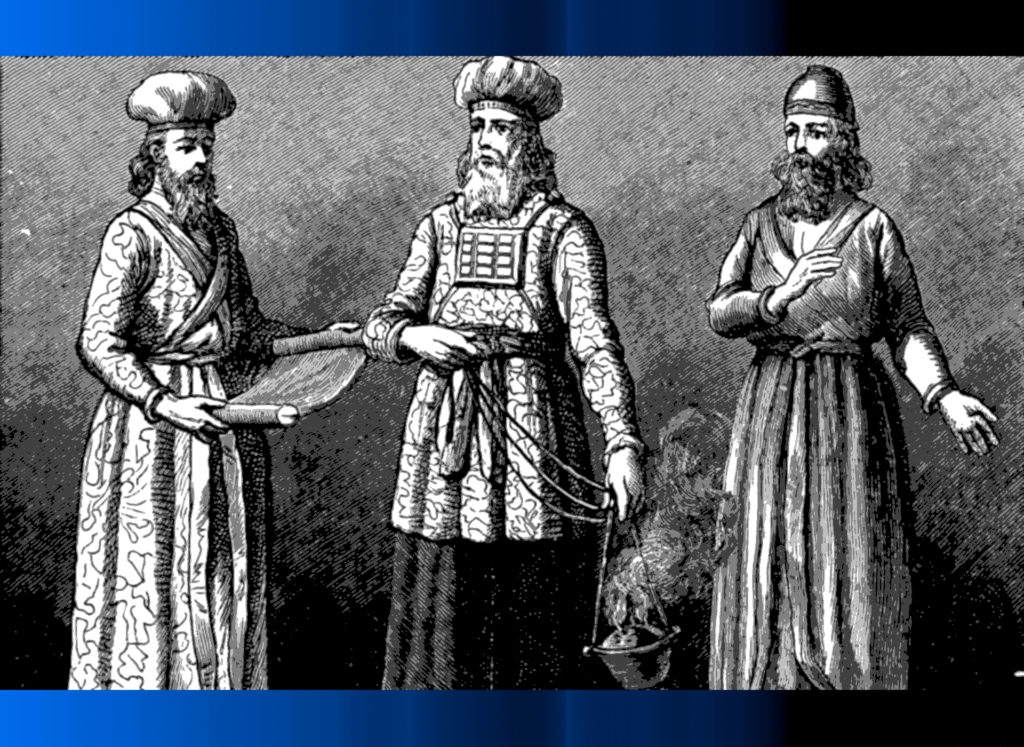
4 – 5 Minute Read
Leviticus 6:1 – 8:36
The Torah parasha, or portion, of Tzav continues the recounting of the commandments of the Almighty through Moses regarding Aaron and his sons as well as the affiliated sacrifices. The burnt offering would remain on the altar and be burned all night until the following morning. Wearing the priestly vestments, he would remove the ashes from the altar and set them beside it. After changing his clothes, he would then bring the ashes outside the camp. A perpetual fire would be kept burning on the altar.
The meal offering would consist of a handful of fine flour mingled with oil and frankincense; no leaven would be used. A token portion would be consumed on the altar, and the rest would be eaten by Aaron and his male descendants only as their portion for all time throughout the ages.
The offering on the occasion of the anointment of a priest would be a portion of fine flour, half in the morning and half in the evening, saturated with oil and cooked on the griddle. It would be consumed entirely by fire on the altar. It would be a law for all time.

The Most High further discussed the sin offering. The spot where the burnt offering was slaughtered was most holy. The priest facilitating the offering would eat of it within the Tabernacle enclosure. If any of the blood bespattered any clothing, it would be washed within the sacred Tabernacle area. Any vessel in which the meat would be cooked would be broken if it was earthen and scoured clean if it was copper. Only the Levitical males could eat of it. If the blood of the sin offering was used inside of the Tabernacle for expiation, no one could eat of it; it would be consumed in fire.
The guilt offering would also be slaughtered at the holy spot, and its blood dashed on the sides of the altar. All [abdominal, intestinal] fat was to be offered along with some of the internal organs, being burned on the altar. The same rules that applied to the sin offering also applied to the guilt offering.
For the sacrifice of well-being, if it was offered for thanksgiving, then unleavened cakes mingled with oil would be offered along with it. The meat of the sacrifice would be eaten on the same day that it was offered; it would not be set aside until the morning.
But if the offering related to vows or a freewill offering, it would be on the same day, and the rest would be eaten the following day. The remainder would be consumed by fire on the third day; it was prohibited to eat any of it by the third day. Only a person who was ritually clean could eat of the various offerings at any time.
The Eternal One told Moses that no [abdominal, intestinal] fat could ever be eaten, although this fat could be used for other purposes if the animal died with no relation to the Tabernacle offerings. No blood of any bird or animal could ever be consumed. Anyone who did so would be cut off from his people.
The Almighty instructed Moses to tell the people of Israel that they must personally present the offerings with their own hands. The breast and right thigh of the sacrifices of well-being would go to Aaron and his descendants, the Levitical priests. It would be their due from the people of Israel for all time throughout the ages.
The Most High spoke to Moses, instructing him to take Aaron along with the anointing oil, the bull of sin offering, the rams, and the basket of unleavened bread. They and the entire community of Israel were to be assembled at the entrance of the Tabernacle.
Moses related to the Jewish people that this was what the Almighty commanded to be done. He dressed Aaron and his sons in the Levitical priestly garments and anointed them with the sacred oil, as well as the Tabernacle and all the items therein. Moses furthered offered the appropriate sacrifices in the prescribed manner. He followed the directions for the [abdominal/intestinal] fat and internal organs, as well as the blood, dashing it on the altar and placing it on the right ears, thumbs, and big toes of Aaron and his sons. Moses consecrated Aaron and his sons as Levitical priests wearing the sacred vestments exactly according to what the Almighty had commanded. Moses further reiterated that they were not to leave the Tabernacle enclosure for seven days until their ordination was complete, eating the proper portions of the sacrifices, so that they did not die. Aaron and his sons did all that the Eternal One had commanded through Moses.

In the twenty-first century, it is sometimes difficult to understand or relate to the sacrificial offerings outlined in the Torah in the Book of Vayikra (Leviticus) and elsewhere. Rabbi Yitzchak Breitowitz once postulated that perhaps the concepts behind the sacrifices of the Mishkan and Beit HaMikdash, Tabernacle and Temple respectively, relate to a kind of “spiritual science,” if you will. The idea presented is that the different physical offerings caused a related spiritual impact in a manner in which we are not always aware. This concept can also be found in other categories of Torah observance. For instance, in addition to physical health, eating only kosher foods is purported to enhance our spiritual health as well. While it is not always clearly defined what these “spiritual health” benefits derived from eating kosher food are, the principle remains in effect. Following the Most High’s commandments in the physical world has relevant and corresponding positive impacts and blessings in a spiritual sense. Such being the case, it could be said that there is some kind of “spiritual science” behind this link and correlation, even if that so-called “spiritual science” is either abstract or otherwise imperceptible to us as finite, physical beings.
Rabbi Breitowitz related an anecdote in which he discussed certain indigenous tribes having an understanding of nature and the world around them that even the most educated society in the modern, western world did not have. For instance, some native tribes are known for their ability to find their way in a dense jungle based on the sounds and movements of certain birds and other animals. There is no college textbook that explains this “ancient knowledge” of nature; but it is undeniable that the members of these so-called “primitive” indigenous tribes are actually highly advanced in their perception of the natural world. In another example, certain tribes of South Africa had a sense of smell so intense that the South African military ordered their special forces units to refrain from even brushing their teeth when they conducted missions in the field. The tribesmen could smell the minty freshness of the South African soldiers from literally miles away. Contrary to the expectations of some, in reality the senses and perceptions of some of these indigenous peoples are in many ways far more advanced than other, more “modern” persons.

The point that Rabbi Breitowitz makes is simply that it is possible that the sacrificial system of the Torah might not be fully comprehensible to us in the twenty-first century, as we are inundated with distractions and other information. However, just like these various tribes hailing from ancient civilizations have areas of comprehension that we do not, so too the people of Israel in ancient times might have comprehended the universe and even the alleged “spiritual science” of the sacrificial offerings in ways that we cannot. What eludes us now might have been common knowledge three thousand years ago.
Regardless, the principle that Judaism operates on the basis of utilizing the physical universe to connect with the Almighty and others and also to achieve both holiness and spirituality remains valid. Whether it is eating kosher food, observing Shabbat, removing leaven from our homes during Pesach, constructing a sukkah booth on Sukkot, etc., the fact is that the Torah outlines physical avenues to enhance our spirituality. And one way or another, whether we fully comprehend how or not, the sacrificial system of the Torah follows the same principle.
Similarly, it should be noted that the Hebrew word used for most sacrifices is actually korban, coming from a Hebrew term meaning “to draw near.” Contrary to popular misconception, the majority of the Torah offerings was not to provide atonement for the offerer. Rather, it was a formula to enable the offeror to draw near to the Almighty after some kind of impurity or unintentional sin. Correspondingly, some are surprised to discover that there is no sacrifice to serve as a korban for a premeditated, intentional sin. In that case, the person was liable for their actions, and was required to confess their sin to the offended party, whether the Most High or a fellow human being, and do teshuvah, make repentance. And, if appropriate, the offender was required to make restitution to the damaged party. If the sacrifices were for the sake of atonement, then there would have been an offering for intentional sin. Instead, the majority of the offerings only relate to a person reconnecting, or “drawing closer” to the Almighty after an unintentional sin or spiritual contamination, or perhaps as a method of expressing thanksgiving or gratitude. It is important to note that the Levitical system of offerings does not make it possible for a person to intentionally sin, such as stealing from his neighbor, and then “get out of” the consequences of that negative action, both in a spiritual sense and in a physical sense. Invariably, he must do teshuvah, repent, and pay back the theft as restitution plus additional penalties.
Another lesson that we can derive from the Torah portion of Tsav relates to the requirement of the common members of the Jewish people to provide for their spiritual leadership. The Levitical priests were entitled to a portion of most of the sacrificial offerings, namely the breast and right thigh of offered livestock animals, and part of the flour and oil offering. The Most High emphasized repeatedly that the Levitical priesthood was entitled to these portions “as a law for all time throughout the ages.” While the Levitical priesthood does not function in the same manner today as in times past, the principle remains the same. We are obligated and required to provide for the physical and/or financial support of our spiritual leadership so that they may, in turn, provide spiritual service and benefits to us as a community.
May the Holy One, Blessed be He, enable us to observe His commandments in the Torah, and by so doing may we use physical means to reach spiritual heights in the proper and prescribed manner. And by using the methodology outlined in the Torah, may we ever “draw closer” to the Holy One, Blessed be He, and bring our families and communities closer to Him and to each other as well.


